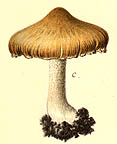Agrocybe pediades
 Key to Gilled Mushrooms Key
Key to Gilled Mushrooms KeyThis is a key to gilled mushrooms, that is, mushrooms having a definite cap with a fertile surface consisting of gills. The fruiting body usually also has a stem, although that may be lateral or absent (usually, then, the mushroom is growing from wood). You can use this key to identify mushrooms that you find.
 Agaricales Order
Agaricales OrderFruiting body containing fibers (usually in the stalk)
 Brown, Olive, Orange or Tan Spored Suborder
Brown, Olive, Orange or Tan Spored SuborderGills not free
Spore print tan, orange, deep ochre, yellowish olive, olive brown, rusty or cinnamon brown or deep brown
Ring usually either absent or not membranous
 Lignicolous Brown Spored Family
Lignicolous Brown Spored FamilyGrowing on wood
 Medium To Big Lignicolous Brown Spored Subfamily
Medium To Big Lignicolous Brown Spored SubfamilyCap usually more than 2" across, and sometimes up to 8; usually tan, yellow, or pumpkin-colored
 Agrocybe Genus
Agrocybe GenusCap dull brown to tan; glabrous (occasionally slimy or viscid); often cracking open like an overripe tomato in age; usually 2-3" across
Fruits in great quantity in wood chips in the springtime
Growing either on hardwood or in grass
Agrocybe pediades (Persoon: Fries) Fayod
Here are the characters that distinguish this species from the others in its group. For its more general characters, see higher up on the page.
If there's just a few words or a microscopic feature here, a more thorough description can be found above.
Diagnosis
- Cap up to 1 1/4" across; yellowish beige
-
Partial veil evanescent
-
In grassy areas
Microscropic Characters
Comments
A. E. Bessette, D. W. Fischer & A. R. Bessette (1997) synonymizes this species with Agrocybe semiorbicularis; R. Phillips (1991) keeps them separate. Arora (1986) summarizes the issues well, I think, by saying that "Agrocybe semiorbicularis is said to have a slightly viscid cap and broader spores, but is otherwise identical." For the splitters among you, the spore ranges that R. Phillips (1991) gives are 9-13 x 6.5-7.5 Ám for Agrocybe pediades, and 11-13 x 7.5-8 Ám for Agrocybe semiorbicularis






 Key to Gilled Mushrooms Key
Key to Gilled Mushrooms Key Agaricales Order
Agaricales Order Brown, Olive, Orange or Tan Spored Suborder
Brown, Olive, Orange or Tan Spored Suborder Medium To Big Lignicolous Brown Spored Subfamily
Medium To Big Lignicolous Brown Spored Subfamily Agrocybe Genus
Agrocybe Genus




